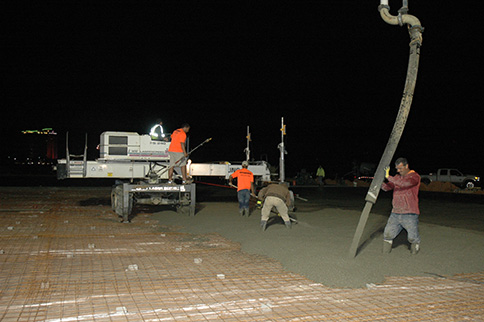
The Brown Precision manufacturing facility, which will fabricate components for use in the aerospace and medical industries, now has a huge footprint in the red clay of Rivercane Industrial Park.
A steady stream of trucks from American Concrete Supply’s Atmore and Flomaton facilities rumbled to and from the site during the wee hours of last Thursday and Friday, dumping more than 1,600 tons of concrete into a pumper to provide the 30,000 square-foot slab for the factory.
“We had 45 trucks in yesterday, we’ll have another 45 today,” Richard Maxwell, owner of Atmore-based Maxwell Construction Company, the project’s general contractor, said around 4:15 a.m. Friday. “This is the pad for the building, the footprint of the building.”
Maxwell said the drought that enveloped the area last fall allowed Atmore-based Lamb’s Dozier Service to complete all site preparation work just in time, but a delay in completion of the plans for the building forced a revision of the construction schedule.
“We have had to readjust the schedule,” he said. “The blueprints caused a delay. We originally wanted to start in October, have the slab poured before Christmas and start the metal building soon after. We did have enough information to get the dirt work done back in an August-September-October time frame, which is our driest time of the year. Had they not done that, we would be in a mess. From the day Chester (Lamb) finished, in November, until the end of the year, we had 38 inches of rain.”
With the slab now poured, things should begin move forward at a steady pace.
“We’ll have this poured today, and there are a few footings out in front that we’ll do in another week or so,” Maxwell said as he watched the progress of the slab application. “But the building itself will be here April 3, and this will have cured out adequately by the time the building gets here. The day it comes in, when they take it off the truck, we’ll start putting the components up.”
He said the process of erecting the building would take “about 15 or 16 weeks.”
The concrete work, for which the structural integrity is reinforced by 50 tons of steel rebar, is being done by Foley-based Ace Concrete, which implemented a “laser tree” to assure that the huge area was level.
“It has targets on each side of the boom (from which the concrete was pumped), and it levels it dead-on-the-money,” Maxwell said. “It makes for a perfectly level slab, with no hiccups. We’ve not used the laser tree before. With it, they can judge what six inches looks like, and they’ve got a man with a come-along, a rake-looking thing, that’s kind of fine tuning it. But the guy with the hose is doing a good job of getting the right amount.”
The general contractor explained that the concrete used today barely resembles the concrete of the past.
“Concrete is a lot more sophisticated than it used to be,” he said. “Thirty-five years ago, it was just sand, gravel, cement and water. Now they put all kind of chemicals and plasticizers in it. The plasticizers make it work like it has a lot of water, without having to have the water. Water will dilute the concrete, but the plasticizer makes it move better and still not lose its compressive strength.”
While the Foley-based foundation contractor specializes in such work, many of the subcontractors for the Brown Precision project are from nearer to home.
Along with Lamb and the local concrete supplier, the list includes Tri-Co Electric Co. of Atmore and (Richard) Boutwell Masonry of Perdido.
“We’ll also use local concrete people for the places the trucks pull in and park,” said Maxwell, who reported that the building’s completion was anticipated “by the end of the year.” Then the process of installing the factory’s equipment will have to be completed before actual production begins.
“Brown’s first occupancy is going to be moving in, installing their equipment,” he said. “They won’t have tons of people crawling all over the place then. They might can start before we’re actually through. One of the last things we have to do is put an epoxy coating on this floor so it will be nice and pretty when they take it.”
The general contractor added that he was keeping his fingers crossed that things would continue to move as they have recently.
“We were delayed getting started, but hopefully we won’t have any more delays,” he said. “Everything is on a pretty good schedule now. I think we have a pretty good handle on everything.”
He paused, placing his hand on his chin, before adding, “Of course, that’s when you get in trouble, so …”
